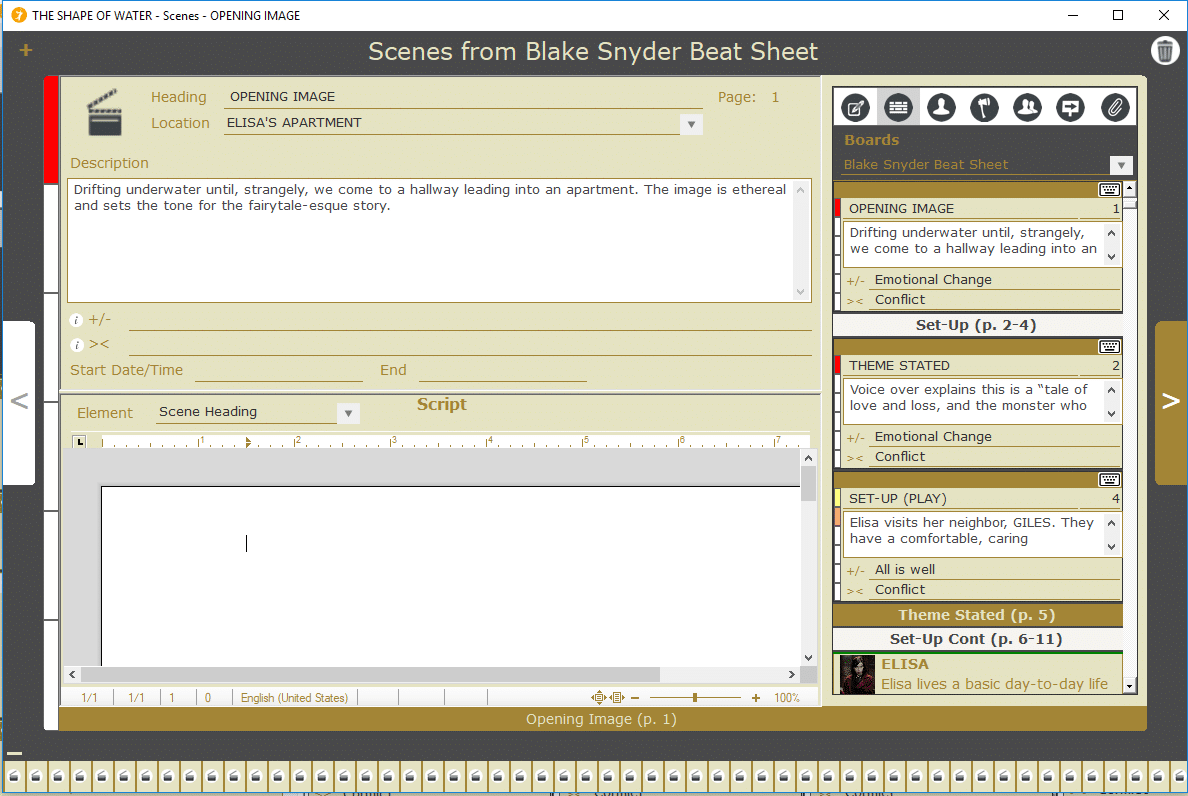WHAT IS SAVE THE CAT!?
 Save the Cat! provides writers the resources they need to develop their screenplays and novels based on a series of best-selling books, primarily written by Blake Snyder (1957- 2009). Blake’s method is based on 10 distinctive genres and his 15 story beats (the Blake Snyder Beat Sheet).
Save the Cat! provides writers the resources they need to develop their screenplays and novels based on a series of best-selling books, primarily written by Blake Snyder (1957- 2009). Blake’s method is based on 10 distinctive genres and his 15 story beats (the Blake Snyder Beat Sheet).
Our books, workshops, story structure software, apps, and story coaching teach you everything you need to unlock the fundamentals and mechanics of plot and character transformation. Our website offers beat sheets, tips and tactics, informative blogs, and guidance for writers — along with sharing the successes of both our teachers and students.
Welcome to the introduction to Save the Cat!
THE TRANSFORMATION MACHINE
As storytellers, we need to meet only one demand: Tell us a story about transformation.
Every story is “The Caterpillar and the Butterfly.” We start with a caterpillar living among the tall branches, eating green leaves, waving “hi!” to his caterpillar pals, little knowing that his is a life of profound deficiency. And then one day, an odd feeling comes over him that’s so scary, it’s like a freefall. Something strange is happening. And that something… is death. That’s what the cocoon stage is. As caterpillar becomes chrysalis, he dies. He, and everything he knows, is no more. Can you imagine?
But when it seems like this purgatory will never end, when things look the most bleak, there’s another stirring. Our hero sees light, and now he breaks through a weak spot in his prison, to sunlight… and freedom. And what emerges is something he never dreamed of when this all began, something… amazing!
Our principles were developed to help you write stories about change — from short films on YouTube to studio blockbusters to best-selling novels. You don’t need anything more than a good idea to get going on your script.
Where do you start? With the Logline.



THE LOGLINE
It’s simple: the logline is one or two sentences that say everything about your story, and can be used as a double-check throughout the screenwriting process. From these few lines, you should be able to break out every element in a successful screenplay!
A good logline has 4 key elements:
- a type of protagonist (your hero)
- a type of antagonist (the bad guy or obstacle)
- a conflict (what’s stopping the hero?)
- an “open-ended question” (what will happen?)
THE 10 GENRES
Genre and structure. These are the two organizing principles around all successful movies — and the STC! method.
A writer’s job is to master the basics of each story type, and learn to give them your own twist that make them ring true for your generation! If you have a story you’re struggling with, and can’t figure out what it’s about, or what kind of story it is, you can check it against these genres to find clues to make your story better, and more meaningful.
The 10 movie genres help writers tell what story they’re writing.
Each genre has 3 components:

The 3 elements of a Buddy Love are:
1) An incomplete hero who is missing something physical, ethical, or spiritual; (s)he needs another to be whole.
2) A counterpart who makes that completion come about or has qualities the hero needs.
3) A complication, be it a misunderstanding, personal or ethical viewpoint, epic historical event, or the prudish disapproval of society.

The 3 elements of a Dude With A Problem are:
1) An innocent hero who is dragged into a mess without asking for it — or even aware of how he got involved.
2) A sudden event that thrusts our innocent(s) into the world of hurt — and it comes without warning.
3) A life or death battle is at stake — and the continued existence of an individual, family, group, or society is in question.

The 3 elements of a Fool Triumphant are:
1) A fool whose innocence is his strength and whose gentle manner makes him likely to be ignored — by all but a jealous “Insider” who knows too well.
2) An establishment, the people or group a fool comes up against, either within his midst, or after being sent to a new place in which he does not fit — at first.
3) A transmutation in which the fool becomes someone or something new, often including a “name change” that’s taken on either by accident or as a disguise.

The 3 elements of a Golden Fleece are:
1) A road spanning oceans, time — or across the street — so long as it demarcates growth. It often includes a “Road Apple” that stops the trip cold.
2) A team or a buddy the hero needs to be guided along the way. Usually, it’s those who represent the things the hero doesn’t have: skill, experience, or attitude.
3) A prize that’s sought and is something primal: going home, securing a treasure, or re-gaining a birthright.

The 3 elements of Institutionalized are:
1) Every story in this category is about a group — a family, an organization, or a business that is unique.
2) The story is a choice, the ongoing conflict pitting a “Brando” or “Naif” vs. the system’s “Company Man.”
3) Finally, a sacrifice must be made and you get three endings: join, burn it down… or commit “suicide.”

The 3 elements of a Monster In The House are:
1) A monster that is supernatural in its powers — even if its strength derives from insanity — and “evil” at its core.
2) A house, meaning an enclosed space that can include a family unit, an entire town, or even “the world.”
3) A sin. Someone is guilty of bringing the monster in the house… a transgression that can include ignorance.

The 3 elements of Out Of The Bottle are:
1) A wish asked for by the hero or another, and the clearly seen need to be delivered from the ordinary.
2) A spell, which we must make logical by upholding “The Rules.”
3) A lesson: Be careful what you wish for! It’s the running theme in all OOTB’s. Life is good as it is.

The 3 elements of Rites Of Passage are:
1) A life problem: from puberty to midlife to death — these are the universal passages we all understand.
2) A wrong way to attack the mysterious problem, usually a diversion from confronting the pain.
3) A solution that involves acceptance of a hard truth the hero has been fighting, and the knowledge it’s the hero that must change, not the world around him.

The 3 elements of a Superhero are:
1) The hero of your tale must have a special power — even if it’s just a mission to be great or do good.
2) The hero must be opposed by a nemesis of equal or greater force, who is the “self-made” version of the hero.
3) There must be a curse for the hero that he either surmounts or succumbs to as the price for who he is.

The 3 elements of a Whydunit are:
1) The detective does not change, we do; yet he can be any kind of gumshoe — from pro to amateur to imaginary.
2) The secret of the case is so strong it overwhelms the worldly lures of money, sex, power, or fame. We gots to know! And so does the Whydunit hero.
3) Finally, the dark turn shows that in pursuit of the secret, the detective will break the rules, even his own — often ones he has relied on for years to keep him safe. The pull of the secret is too great.
THE BLAKE SNYDER BEAT SHEET
Blake’s Genres tell us how movies can be different. But how can they be the same?
Blake codified a common structure, a universal key to unlock every successful story: the 15 story beats of the Blake Snyder Beat Sheet (the pages of your screenplay or novel are noted by the percentage marker that follows each beat name):
ACT 1: The Ordinary World – Thesis
BEAT 1 – OPENING IMAGE (0–1%)

A thematic or grabbing visual image, scene, or short sequence which sets the tone of your movie. It often serves as the “before” picture of your hero (or world) that will transform throughout the story.
BEAT 2 – THEME STATED (5%)

A line of dialogue that organically states what your story is all about. The theme is typically voiced by another character to your hero, calling out the hero’s deeper flaw or spiritual need for change.
BEAT 3 – SET-UP (1%-10%)

Reveals your main character’s “ordinary life” or status quo. Takes time to demonstrate a character’s flaws that negatively impact the hero’s life. Describes the character’s familiar world when it comes to home, work, and play, and introduces the main characters who inhabit the hero’s life.
BEAT 4 – CATALYST (10%)

The life-changing moment that happens to the hero and sets the story in motion. Provides that initial shove onto the story roller coaster.
BEAT 5 – DEBATE (10%-20%)

The reaction to the Catalyst, usually presented in the form of a question (“Do I really have to go on this dangerous quest?”). Can be a sequence of doubt, denial, evasion, or even preparation. It lends weight to the life-changing bigger journey yet to come and foreshadows the new world as one that you do not enter lightly.
ACT 2: The Upside-Down World – Antithesis
BEAT 6 – BREAK INTO 2 (20%)

The hero decides to take action and locks in to accomplish a goal, venturing into a new world, or choosing a new way of thinking. This is a no-turning-back decision that separates the old, ordinary world from the new world.
BEAT 7 – B STORY (22%)

A thematic secondary story is kicked off. Often, this is a story about love or friendship or mentorship.
BEAT 8 – FUN & GAMES (20%-50%)

The hero is in the new world. This beat delivers on the promise of the premise. It’s a large section of the story that essentially presents “the movie you came to see.” Contains scenes and sequences that are shown in the trailer of movies or hinted at in the blurb on the back of the book or on that “Coming Next Week” teaser at the end of a TV show.
BEAT 9 – MIDPOINT (50%)

The middle of the story and culmination of the Fun & Games. Usually, this beat is a false victory or a false defeat. The Midpoint raises the stakes on the hero, forcing them to narrow their focus on winning the day or surviving. Often, a ticking clock is introduced here, ratcheting up tension and boosting the urgency.
BEAT 10 – BAD GUYS CLOSE IN (50%-75%)

Stakes have raised and tension is higher. External Bad Guys may be literally closing in or psychological, internal Bad Guys may be causing more problems.
BEAT 11 – ALL IS LOST (75%)

The moment the hero most feared actually happens. Now it looks like the hero will lose. Usually contains a whiff of death where someone has died or the threat of real death is in the air. This is the hero’s rock-bottom moment.
BEAT 12 – DARK NIGHT OF THE SOUL (75%-80%)

A reaction to the All Is Lost where the hero wallows in sadness, mourning what was lost and lamenting that they are now worse off than before the story began. This is an opportunity to take stock, where meaningful learning happens on the way to transformation.
ACT 3: Merged World – Synthesis
BEAT 13 – BREAK INTO 3 (80%)

A new piece of information is discovered and the hero realizes what they must do to solve all the problems that have been created in Act 2.
BEAT 14 – FINALE (80%-99%)

The big showdown where the hero finally proves they’ve learned the lesson that was taught via their struggles in Act 2. The quest is won, the dragon is slain, and when the smoke clears, the hero has changed. Their flaw is repaired and the world is indeed a better place.
BEAT 15 – FINAL IMAGE (99%-100%)

The “after photo” of the hero and the world. A mirror of the Opening Image. Shows how far the world and the hero have transformed.

THE BOARD
Once you’ve filled in your Blake Snyder Beat Sheet, you’re ready to tackle The Board.
The Board is the fabled device, seen in executive offices all over Hollywood, which allows you to “see” your movie before you begin writing by using 3 x 5 index cards, scotch taping them to a wall. It’s a way to easily test different scenes, story arcs, ideas, bits of dialogue, and story rhythms — and decide whether they work.
And though it is not really writing, and though your perfect plan may be abandoned in the white heat of actually executing your screenplay, it is on The Board where you can work out the kinks of the story. It is your way to visualize a well-plotted movie, the one tool I know of that can help you build the perfect beast.

The Board is broken down into four rows, 10 cards per row for a total of 40 — a good average count for the number of beats in the average movie.
Row #1 is Act One; the last card in that row, the Break into Two, is your first major turn.
Row #2 is the first half of Act Two up to the Midpoint. This is where your B Story and Fun and Games cards will appear.
Row #3 includes your Bad Guys Close In and All Is Lost cards leading to the final major turn, the Break into Three.
Row #4 concludes your screenplay with the Finale and Final Image cards.
And now, a shameless plug: Our software provides a “virtual” Board with cards already labelled with Scene Headings and more. In fact, because each scene is like a mini-movie with a beginning, a middle, and an end, we give you two more things to fill out on each card: the >< which indicates Conflict (who is in opposition to whom) and the +/- which indicates Emotional Change. Just like every good movie, every good scene has to have clear conflict and some emotional shift from start to finish. Filling in these symbols on every card prepares you to write quickly and confidently knowing EXACTLY what must happen in EVERY scene.
It couldn’t be easier. Fill in The 40 completely and honestly, and you’ve got an iron-clad structure before you begin writing your novel or screenplay.
Check out the Save the Cat! Story Structure Software – Your Digital Writers Board
5 Comments
Comments are closed.


Hello everyone, thank you for welcoming me to this group. I have been looking for a community like this one for a long time. I enjoy writing screenplays and producing my own low budget films. I stumbled across this community while completing a work assignment for school. I suddenly feel a great sense of peace of mind knowing that there is an entire community dedicated to storytelling. Reading the different posts and replies in this community has inspired me to continue writing. I now know I am part of a community of like-minded individuals who share a common goal, storytelling. Thank you again for allowing me to be part of this community. I hope to connect with as many of you as possible in the future.
My name is Diane Revilla, and I am an independent filmmaker in Austin, Texas. I produced a film in 2019 right before the pandemic, titled barrio of mansions that went on to win three awards in film festivals that I submitted to. I am currently making the most of the time away from work due to the pandemic. I was working as a videographer for a small newspaper called La Prensa. I actually got the golden idea for my screenplay barrio of mansions from the work I did in the newspaper. You see, I would cover issues facing the Latino Community in Austin, issues like displacement, gentrification, systematic racism, and unfair treatment. I tackled issues like closures of community’s school being forced out, to make room for developers to have their high-rises. I am currently writing my next screenplay. I hope to get as much useful knowledge from this as possible, and I feel so happy to become part of this community.
Hey D. Revilla, I too am relatively new to this group and would like to find someone to bounce ideas off of from time to time and just talk about the industry. At this point I just write scripts but let me know if you’d like to talk screenwriting or again the industry in general. My email is [email protected] and you can look me up on Filmfreeway – https://filmfreeway.com/patricknorman – Take care D! Patrick Norman
Hi all,
How are you? My name is Rahco, im currently a film student at LA Film school. I am still having trouble trying to figure out how to post topics on this site can anyone give me tips? I am however replying and attempting to post from my cell if that helps. However this is an amazing wealth of knowledge on this site wow. I’m glad I choose this as my new platform. Talk soon.
Hey there good evening, The name is Julia . I am also a film student. This site is loaded with interesting material. But it it is hard to navigate a little bit. I would love to get a conversation started about the industry and play off some ideas. I can write But I’m more into being behind the camera and working with a director to help there work come to life. Any in-sight please let me know.
Hey everyone my name is the same as the country singer whose hit song is “Tennessee Whiskey”. I am new to this blog. I am also a new film student as well. I really am interested in learning new ideas and criticism to gain as much knowledge as I possibly can. I would like to receive some helping actually posting instead of replying. If anybody could help me out with that I would appreciate it. Thanks